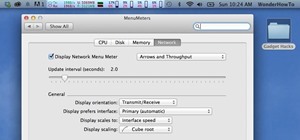Word to the wise: this works best if you have an extra monitor. Here’s how to do it. Using Dual Monitors – Speaking of multiple monitors, use the dual-monitor display feature to place the video and screen-share layouts on different screens and take advantage of that extra real estate. How to Set Up Dual Monitors on a Mac If you need a large display for your Mac, do yourself a favor and grab a decent 27-inch or larger computer monitor. It doesn't need to be a Thunderbolt display; just about any monitor with a DisplayPort or Mini DisplayPort will work very well with any of the Macs listed in this article.
Check display support
You can connect one or more external displays depending on your Mac model. To find out how many external displays your Mac supports, check its technical specifications:
- Choose Apple menu > About This Mac.
- Click the Support tab.
- Click Specifications.
- On the webpage that appears, the number of displays your Mac supports appears under Video Support or Graphics.
If you're using a Mac with Apple silicon, you can connect a single external display to your Mac using one of the Thunderbolt / USB 4 ports. Docks don't increase the number of displays you can connect as an extended desktop. On Mac mini (M1, 2020), you can connect a second display to the HDMI port.
Connect your display
Connect your display to power, then connect your display to your Mac. Check the ports on your Mac to find out whether you need an adapter.
Change display options
After you connect your display, you can choose to extend your desktop or mirror your displays.
Use extended desktop mode
- Choose Apple menu > System Preferences, then click Displays.
- Click the Arrangement tab.
- Make sure that the Mirror Displays checkbox isn’t selected.
- Arrange your displays to match the setup on your desk. To change the position of a display, drag it to the desired position. A red border appears around the display as it's moved.
- To set a different display as the primary display, drag the menu bar to the other display. The primary display is where your desktop icons and app windows first appear.
Mirror your displays
- Make sure that your external display is turned on and connected to your Mac.
- Choose Apple menu > System Preferences, click Displays, then click the Arrangement tab.
- Make sure that the Mirror Displays checkbox is selected.
Use AirPlay
With Apple TV, you can use your TV as a separate display for your Mac. Learn how to use AirPlay to mirror or extend your Mac display.
Learn more
Dual Monitor Hacks Machinery
While almost all aspects of M1 Mac performance are greatly improved compared to the Intel Mac predecessors, one notable downside has been reduced support for external displays. In what looks like some exciting news, it appears Apple may be underselling the M1 Mac external display functionality.
Apple says in its tech specs the M1 MacBook Air and 13-inch MacBook only support up to 1 external display up to 6K at 60Hz. And the Mac mini up to 1 6K at 60Hz over USB-C/Thunerbolt and 1 display up to 4K at 60Hz over HDMI.
However, just like we’ve seen in the past when Mac compatibility with Apple’s Pro Display XDR was found to be broader than Apple says, it appears that M1 Macs can indeed run up to 6 external displays with good performance… at least in early testing.
YouTuber Ruslan Tulupov has shared two videos demonstrating the workaround he discovered (via MacRumors).
Dual Monitor Hacks Mac Os

The workaround isn’t too complicated and involves downloading the DisplayLink software for macOS (Tulupov says works fine with Big Sur) and picking up a 4K DisplayPort to USB 3.0 adapter (and/or HDMI adapter).
Depending on how many displays you want to run with this trick, you might need a USB-C to USB-A 3.0 adapter or a Thunderbolt or USB-C dock as well as additional cables, etc.
You can check out a detailed walkthrough of the setup in the videos below. Interestingly enough, he says the M1 Mac mini and MacBook Air he tested performed “awesome” overall under a heavy load playing YouTube videos and the highest resolution available and even using Final Cut Pro without dropping hardly any frames.
With his workaround, he shows the Mac mini running up to 6 displays and the MacBook Air running 5 external displays. Also notable, he says he didn’t even see the Mac mini fan kick up during his testing. In the examples below, not every display was running at 4K, but the workaround still appears very impressive.
Check out the full videos below for exactly how he configured these setups. The second video includes a Q&A section.
Accessories/adapters he used include:
- StarTech USB 3.0 to DisplayPort 4K single adapter
- StarTech USB 3.0 to DisplayPort 4K dual adapter
- StarTech USB 3.0 to HDMI 4K adapter
Dual Monitor Hacks Machine
FTC: We use income earning auto affiliate links.More.